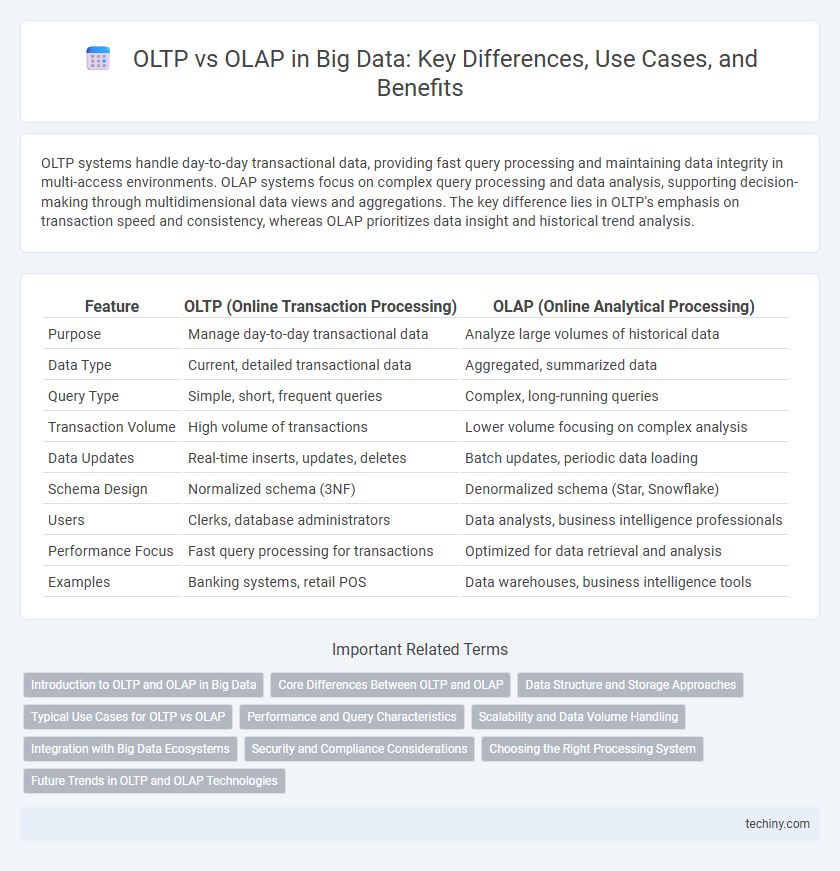OLTP systems handle day-to-day transactional data, providing fast query processing and maintaining data integrity in multi-access environments. OLAP systems focus on complex query processing and data analysis, supporting decision-making through multidimensional data views and aggregations. The key difference lies in OLTP's emphasis on transaction speed and consistency, whereas OLAP prioritizes data insight and historical trend analysis.
Table of Comparison
| Feature | OLTP (Online Transaction Processing) | OLAP (Online Analytical Processing) |
|---|---|---|
| Purpose | Manage day-to-day transactional data | Analyze large volumes of historical data |
| Data Type | Current, detailed transactional data | Aggregated, summarized data |
| Query Type | Simple, short, frequent queries | Complex, long-running queries |
| Transaction Volume | High volume of transactions | Lower volume focusing on complex analysis |
| Data Updates | Real-time inserts, updates, deletes | Batch updates, periodic data loading |
| Schema Design | Normalized schema (3NF) | Denormalized schema (Star, Snowflake) |
| Users | Clerks, database administrators | Data analysts, business intelligence professionals |
| Performance Focus | Fast query processing for transactions | Optimized for data retrieval and analysis |
| Examples | Banking systems, retail POS | Data warehouses, business intelligence tools |
Introduction to OLTP and OLAP in Big Data
OLTP (Online Transaction Processing) systems focus on managing real-time transactional data, supporting high-volume, short online transactions essential for day-to-day operations such as order entry and retail sales. OLAP (Online Analytical Processing) enables complex queries and multi-dimensional analysis, facilitating trend identification and strategic decision-making through aggregated historical data. In Big Data environments, OLTP emphasizes data consistency and speed, while OLAP optimizes data retrieval and analytical processing at scale.
Core Differences Between OLTP and OLAP
OLTP systems prioritize high-speed transaction processing with numerous short online transactions, ensuring data integrity and rapid query processing for day-to-day operations. OLAP systems focus on complex queries and data analysis, aggregating large volumes of historical data to support business intelligence and decision-making. The core difference lies in OLTP's record-level transaction efficiency versus OLAP's multi-dimensional data analysis and reporting capabilities.
Data Structure and Storage Approaches
OLTP systems utilize highly normalized data structures designed for fast transaction processing and efficient storage of real-time operational data, often implemented in relational databases with row-oriented storage. OLAP systems employ denormalized or multidimensional data models, such as star or snowflake schemas, optimized for complex queries and analytical processing, frequently stored in columnar databases or data warehouses. Storage approaches in OLTP prioritize write efficiency and quick, atomic transactions, whereas OLAP emphasizes read performance and aggregation over large datasets to support business intelligence and decision-making.
Typical Use Cases for OLTP vs OLAP
OLTP systems are optimized for managing day-to-day transactional data such as order entry, retail sales, and banking transactions, supporting high volume of short online transactions. OLAP systems handle complex queries for multidimensional analysis, commonly used in business intelligence tasks like sales forecasting, financial reporting, and market trend analysis. OLTP ensures real-time transactional consistency, while OLAP provides historical and aggregated data insights for strategic decision-making.
Performance and Query Characteristics
OLTP systems prioritize high transaction throughput with rapid query response times, handling numerous short, atomic operations on normalized databases to ensure data integrity and concurrency. OLAP platforms optimize complex, read-heavy queries that aggregate large volumes of denormalized data, supporting multidimensional analysis and trend discovery. Performance in OLTP emphasizes low latency for real-time transaction processing, whereas OLAP focuses on maximizing query efficiency for extensive data scans and analytical computations.
Scalability and Data Volume Handling
OLTP systems prioritize fast transaction processing with high concurrency, making them highly scalable for managing large numbers of short, real-time operations but typically handle smaller data volumes compared to OLAP. OLAP systems are designed for complex queries and analytics on massive datasets, supporting scalable data aggregation, historical data analysis, and multidimensional queries. While OLTP excels in vertical scalability for numerous transactional records, OLAP focuses on horizontal scalability to efficiently process and analyze vast amounts of data in data warehouses.
Integration with Big Data Ecosystems
OLTP systems prioritize real-time transaction processing with high concurrency, making them essential for operational databases within Big Data ecosystems, enabling immediate data capture and updates. OLAP systems specialize in complex analytical queries and multidimensional data analysis, integrating with Big Data platforms like Hadoop and Spark to process large-scale datasets for business intelligence. The synergy between OLTP and OLAP in Big Data environments drives comprehensive data management, offering both operational efficiency and deep analytical insights.
Security and Compliance Considerations
OLTP systems prioritize real-time transaction security through stringent access controls, encryption, and audit trails to ensure data integrity and compliance with regulations like PCI DSS and GDPR. OLAP systems require robust data governance frameworks to handle aggregated data securely, emphasizing compliance with privacy laws such as HIPAA and CCPA while enabling secure multi-dimensional analysis. Both systems must implement role-based access controls and continuous monitoring to prevent unauthorized access and maintain regulatory adherence in Big Data environments.
Choosing the Right Processing System
OLTP systems excel at managing high-volume, real-time transactional data for day-to-day operations, ensuring data integrity and speed essential for applications like banking and e-commerce. OLAP systems are designed for complex queries and multidimensional analysis, supporting business intelligence and decision-making by processing large historical datasets. Selecting the appropriate system depends on whether the primary need is transactional efficiency or analytical depth, balance data consistency, query complexity, and response time.
Future Trends in OLTP and OLAP Technologies
Future trends in OLTP technology emphasize enhanced real-time transaction processing capabilities, driven by advancements in in-memory databases and edge computing to support instantaneous data updates. OLAP systems are evolving through the integration of AI and machine learning for automated data analysis and predictive insights, enabling more dynamic and complex querying over large-scale data warehouses. The convergence of OLTP and OLAP platforms is gaining traction, facilitating hybrid transaction/analytical processing (HTAP) to provide unified, real-time operational and analytical information.
OLTP (Online Transaction Processing) vs OLAP (Online Analytical Processing) Infographic

 techiny.com
techiny.com